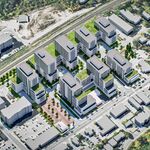Cut and cover is not inferior or superior to a TBM. No different than any other construction method for anything. They both have their upsides and downsides.
TBMs are best used in dense urban areas where you have to cut under buildings, and where roads are impossible to deal with. The prime example are European Downtowns where streets are narrow and a complete mess: You won't be able to build anything cut and cover under Rome for instance.
Sheppard is a massive 5 lane stroad, the absolute perfect condition to build C&C.
If we look at the design aspect, parts could be both.
Yes, we will have to TBM under the 404. That's it.
No, they were being dismissive.
If you still don't get it, I was being dismissive because you just blurted out words without even trying to back it up.
How exactly does Sheppard being an extension change
ANYTHING? Please for the love of god give 1 example. Yes Sheppard uses a different rolling stock, but please give
AT LEAST ONE reason why the difference in rolling stock matters here.
You can't just say words and expect them to work as arguments.
I asked that because by knowing what projects they want to mimic,it allows me to temper my answers to show whether it is superior or inferior. IIRC in Toronto, except for some of the streetcar tunnels, everything since the 1960s has been bored tunnel. Even the most recent Line 5 debacle has been bored tunnel.
BD Phases 1 and 2 (1966 and 1968 respectively) were cut and cover.
Yonge North extension to Finch: Mix of TBM and Cut and Cover (TBM between Eglinton and Sheppard, Cut and Cover from Sheppard to Finch). TBMs were used here because they needed to tunnel under the Valley at York Mills (and even then in hindsight this was probably a bad idea, you could've easily bridged over York Mills).
Spadina Subway: Almost entirely cut and cover except for the section between Dupont and St. Clair West where it must run under Casa Loma, you know, a giant historical castle.
BD Extension to Kennedy: Was built Cut and Cover
SRT: The tunnel under the Stouffville Line wasn't bored.
Line 1 Extension to Downsview (Sheppard West): Built Cut and Cover.
LITERALLY the first time we built a project exclusively using TBMs was the Sheppard Subway in 2002, and that was probably a bad idea.
So no, you're just flat out wrong, period.
One big one is it can avoid certain geotechnical problem that cut and cover would be problematic to deal with. It can also pass under any water body that is along the route. It also can pass under the 401 without any disruptions. It can pass under existing rail tracks without any disruptions.
Nobody is arguing that a TBM won't be used under the 404. We have literally talked about how it will be a TBM pages ago. But just because that one section needs to be TBMed doesn't mean we need to tunnel bore the entire line. Practically we can extract it at around Consumers, and build the rest elevated or C&C.
The jury is still out on how Agincourt will be handled.
Cut and cover is cheaper. Cut and cover can be done quicker. What other benefits, besides cost make it the better option?
Do you want to know why I'm very dismissive of the stuff you say? Because you have a tendency to just completely ignore and pretend you didn't read what people have ALREADY WRITTEN YOU.
But, let me reiterate again. Because Cut and Cover results in shallower stations, it means the stations are significantly more accessible. It means it can take 30s to get from the surface to the platform, and not 2 minutes. It means it can take as few as 15 steps to reach from surface to platform, compared to the super long escalator rides.
Like I can't stress this point enough: go to Union Station, and see how long it takes you to get from the street to the platform. Then Ride Line 1 to any station on the TYSSE, and do the same measurement. Accessing the TYSSE stations are so much worse and annoying its not even funny.
None of them were irrelevant.
Explain How. Just give us
SOMETHING to work with.




